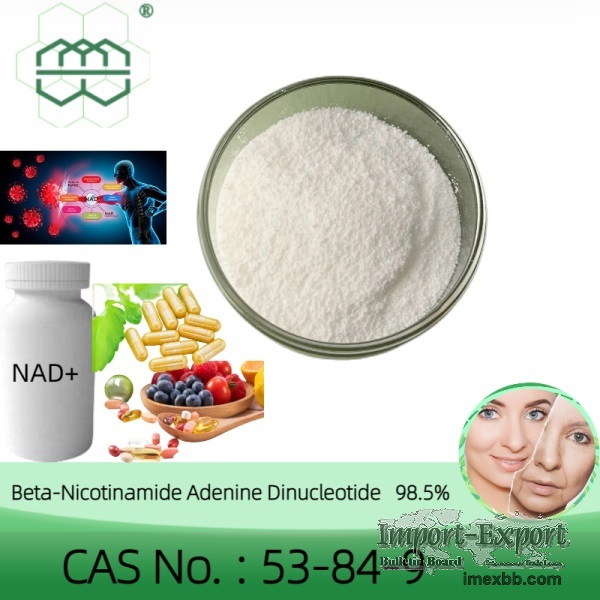 |
 |
Home > Offers to Sell > Chemicals & Plastics > Others > Others
| Contact: | Juanna Chan |
|---|---|
| Company: | Suzhou Myland Pharm & Nutrition Inc. |
| No# 262 Dongping St. SIP Suzhou CN. | |
| Suzhou 215123 | |
| China | |
| Phone: | +8651266702819 |
| E-Mail: | |
| Date/Time: | 6/19/23 5:14 GMT |
NAD+ CAS No.: 53-84-9 98.5% purity min. Antidepressant
Product name:NAD+
Other name :OSTEOPONTIN,GSTFUSION;)-1-beta-d-
ribofuranosy , lpyridiniumhydroxide,innersalt;adenine-
nicotin , amidedinucleotide;adenosine5’-(trihydrogendiphos , phate),p’.fwdarw.’-
esterwith3-(aminocarbon , yl;Adenosine5’-(trihydrogendiphosphate),P’.fwd , arw.5’-
esterwith3-(aminocarbonyl)-1-.beta.-D , -ribofuranosylpyridinium,innersalt;beta-
diphos , phopyridine;cozymasei;enzopride
CAS No.:53-84-9
Molecular formula:C21H27N7O14P2
Molecular weight:663.43
Purity:98.5%
Appearance :White to yellowish powder or crystalline powder
Application:Dietary Supplement Raw Material
3.Product introduction
NAD+, or nicotinamide adenine dinucleotide, is a coenzyme found in all living
cells. It plays a vital role in cellular metabolism, specifically in redox
reactions, which involve the transfer of electrons between molecules. NAD+ is
involved in both anabolic and catabolic reactions, making it an essential component
of energy metabolism.
In its oxidized form (NAD+), the coenzyme functions as an electron acceptor, while
in its reduced form (NADH), it acts as an electron donor. This redox reaction is
essential in processes such as glycolysis, the citric acid cycle, and oxidative
phosphorylation, which produce ATP, the primary energy source for cells.
NAD+ is also involved in other cellular processes, such as DNA repair, gene
expression, and calcium signaling. It is important for maintaining healthy aging,
as NAD+ levels decline with age, leading to a decrease in cellular metabolism and
an increase in cellular damage.
There are several ways to increase NAD+ levels in the body, such as through dietary
supplementation, exercise, and calorie restriction. NAD+ precursors, such as
nicotinamide riboside, have been shown to increase NAD+ levels and improve cellular
metabolism, potentially benefiting aging-related diseases.
Overall, NAD+ plays a crucial role in cellular metabolism and is involved in
various cellular processes. Its decline with age highlights its importance in
maintaining healthy aging, and strategies to increase NAD+ levels are being studied
for their potential therapeutic benefits.
4.Features
(1) High versatility: NAD+ has a versatile role in cellular metabolism, serving as
a cofactor for numerous enzymes involved in energy production, DNA repair, and
cellular signaling.
(2) Essential for cellular function: NAD+ is essential for many cellular processes,
including the conversion of food into energy, DNA repair, and regulation of gene
expression.
(3) Anti-aging potential: NAD+ levels decline with age, and this decline is
associated with age-related diseases. Supplementation with NAD+ precursors has been
shown to increase NAD+ levels and has potential anti-aging effects.
(4) Neuroprotective properties: NAD+ has been shown to have neuroprotective
properties, which may be beneficial for the treatment of neurodegenerative diseases
such as Alzheimer's and Parkinson's disease.
(5) Potential for cancer treatment: NAD+ plays a crucial role in DNA repair, and
targeting NAD+ metabolism has been proposed as a potential strategy for cancer
treatment.
(6) Implicated in metabolic diseases: Dysregulation of NAD+ metabolism has been
implicated in the development of metabolic diseases such as diabetes and obesity,
making NAD+ an attractive target for therapeutic interventions.
5.Applications
NAD+ is a coenzyme that plays a crucial role in various biological processes,
including energy metabolism, DNA repair, and cell signaling. NAD+ has been studied
extensively in recent years, and its potential therapeutic applications have been
explored in various diseases, such as cancer, neurodegenerative disorders, and
metabolic diseases.
In cancer, NAD+ has been shown to play a role in DNA repair and cancer cell
survival. Targeting NAD+ metabolism has been suggested as a potential therapeutic
strategy for cancer treatment.
In neurodegenerative disorders, NAD+ has been found to be involved in the
regulation of neuronal activity, mitochondrial function, and neuroinflammation.
Boosting NAD+ levels has been proposed as a potential treatment for Alzheimer's
disease, Parkinson's disease, and Huntington's disease.
In metabolic diseases, NAD+ has been shown to play a crucial role in the regulation
of energy metabolism and insulin sensitivity. Boosting NAD+ levels has been
suggested as a potential treatment for type 2 diabetes and obesity.
Furthermore, NAD+ has been studied for its potential anti-aging properties. NAD+
decline has been implicated in the aging process, and boosting NAD+ levels has been
suggested as a potential strategy for slowing down aging and promoting healthy
aging.
Overall, the applications of NAD+ are still being explored, and its potential
therapeutic benefits in various diseases make it an exciting area of research with
significant clinical implications.
Minimum Order: 1 bags
SOURCE: Import-Export Bulletin Board (https://www.imexbb.com/)
![]()
© 1996-2010 IMEXBB.com. All rights reserved.
|
|
|
